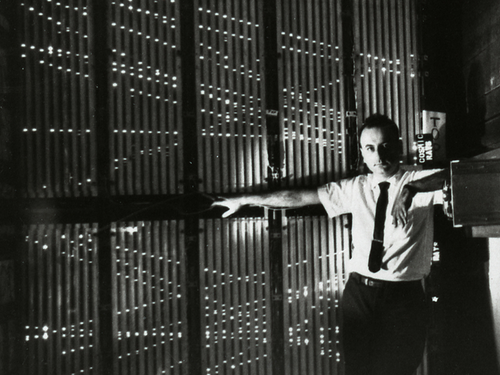Landmarks—Discovery of a 2nd Kind of Neutrino
Landmarks articles feature important papers from the archives of the Physical Review journals.
Neutrinos are ubiquitous, but, because of their feeble interactions with other particles, they are hard to control and detect. The 1962 discovery of the muon neutrino, a cousin to the previously known electron neutrino, was an important fundamental result but was also the first demonstration of a method for creating a neutrino beam as an experimental tool. The 1988 Nobel Prize in Physics citation gave equal recognition to both aspects of the work, and today’s neutrino experiments still use the same fundamental method.
After the 1953 discovery of the neutrino [see Focus Landmark—Detecting the Elusive Neutrino], physicists were eager to investigate the weak force that governed neutrinos’ interactions with matter, but they were short of experimental means to do so. At the end of that decade, Bruno Pontecorvo of the Joint Institute for Nuclear Research in Dubna, USSR, and Melvin Schwartz of Columbia University in New York City and Brookhaven National Laboratory (BNL) on Long Island, New York, independently came up with a method for creating an almost pure beam of neutrinos [1, 2]. Schwartz then joined forces with Leon Lederman, Jack Steinberger, and others, all from Columbia and BNL, to put the idea into practice.
The team used BNL’s Alternating Gradient Synchrotron (AGS) to generate a beam of protons with an energy of 15 giga-electron-volts (GeV). This beam slammed into a beryllium target, producing large numbers of pions, which then began to decay into muons plus neutrinos. This beam, neutrinos mixed with pions, muons, some of the original protons, and no doubt other particles too, then passed through a wall of steel 13.5 meters thick. The requisite quantity of metal came from a recently decommissioned battleship, the USS Missouri.
The vast majority of neutrinos sailed through the mass of steel unaffected, but only about one in of the pions survived, according to the team’s calculations. Other charged particles were similarly suppressed. This enormous attenuation was essential because detecting neutrinos is so difficult—even a tiny amount of contamination could obscure the results.
To detect neutrinos, the researchers built a 10-ton spark chamber consisting of 90 1-inch-thick aluminum plates separated by 3/8-inch, gas-filled gaps. As neutrinos flooded through the chamber, one would occasionally strike a proton in an aluminum nucleus, producing a neutron and either an electron or a muon, according to theory. This charged particle would ionize the gas, creating a visible spark track when high voltages were applied across the plates.
During several months of experimental runs, an estimated protons hit the beryllium target. Out of this assault, the detector yielded just 113 events that met the experimenters' criteria as potential neutrinos. Some turned out to be due to low-energy muons reaching the spark chamber directly from the AGS; others originated from background neutrons or cosmic rays. But the researchers identified 51 events triggered by high-energy neutrinos that had passed through the steel wall. The tracks from these events passed through the aluminum plates without further interaction, which electrons would not do. So the team concluded that collisions in the detector produced only muons, strongly suggesting that the neutrinos in the beam were “likely different from the neutrinos involved in beta decay” (which involves electrons).
This was by no means a surprising conclusion; the existence of a separate kind of neutrino had already been proposed for theoretical reasons. Weak interaction theory implies that when a muon decays into an electron it produces a neutrino-antineutrino pair, and this pair should have a certain probability to merge and produce a photon. But no one had observed a photon-producing muon decay. A simple explanation was that the neutrino and antineutrino were of two different types that could not combine.
This experiment convinced physicists that a second type of neutrino—the muon neutrino—indeed existed, winning the 1988 Nobel Prize in Physics for Schwartz, Lederman, and Steinberger. Mark Messier of Indiana University in Bloomington, a member of the NOvA Neutrino Experiment, which is searching for transformations of muon neutrinos into electron neutrinos, says that the Schwartz-Lederman-Steinberger technique for creating a neutrino beam “was a major advance which opened a whole new way to study neutrino properties.” He says that the method is one “that we are still not finished exploiting.”
This research is published in Physical Review Letters.
–David Lindley
David Lindley is a freelance science writer in Alexandria, Virginia.
References
- B. Pontecorvo, J. Expt. Theor. Phys (USSR) 37, 1751 (1959), [Sov. Phys. JETP 10, 1236 (1960)].
- M. Schwartz, Phys. Rev. Lett. 4, 306 (1960).





